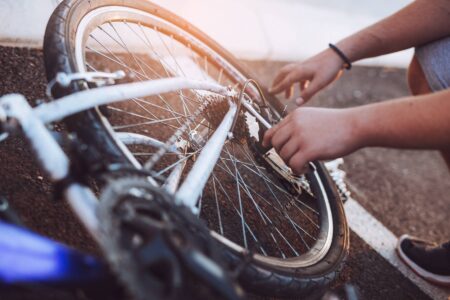Even if you do no maintenance on your wheels at all, it’s important that you know how to take them off so that you can fix punctures. It’s even more vital to be able to refit them securely – you really don’t want to lose wheels as you ride along.
If you’re not confident, ask your bike shop or an experienced rider to go through the procedure with you. When buying new wheels, if you’re not familiar with the fitting system, ask your shop to show you how to remove and refit them.
The standard quick-release lever was designed for road-racing bicycles. It’s a great system, allowing you to lock your wheels in place without tools. But the original designers of the quick-release lever had no idea what we would be doing with bicycles now.
Suspension for bicycles existed already, but was a feature of butchers’ and postmen’s bikes and they seldom tended to use their machines for hurtling around off-road with six inches of suspension. The design has been modified along the way to make the fitting more secure – the ”lawyer tabs” at the bottoms of your fork dropouts force you to undo your quick-release lever nut a few turns before you can release the wheel. This gives you a little more time to notice that something is wrong before your front wheel jumps out and plants you face first in the dirt.
Similarly, the move from horizontal rear dropouts, which allow you to adjust the chain tension, was necessary to make wheels more secure. Once common on mountain bikes, these are now seen only on singlespeed- specific frames. The arrival of disc brakes has meant that hubs are subject to even stronger forces. Therefore, quick-release skewers need to be tightened securely and checked regularly. Forks for downhill and freeride often have chunkier release mechanisms, which aren’t as instant, but are more resistant to accidental release. If you find that your skewers work loose during rides, take your bike to your shop for a second opinion.
There is some disagreement about the best position for the lever. Traditionally, quick- release skewers were oriented so that the lever was on the left-hand side of the bicycle and lay along one of the stays to prevent it getting caught.
On mountain bikes it’s important that the levers don’t point straight forwards, because they could get caught on a branch as you ride past and flip open. I prefer to fit them on the opposite side to disc rotors, as this reduces the chances of getting burned when fixing punctures. But the shape of your forks will often dictate where the skewer can fit, especially if there are adjusting knobs or fitting bolts behind the dropout. The most important thing is to ensure that the levers are firmly fitted. A ziptie around the skewer as an extra line of defence does no harm – I especially like Shimano XT skewers for this, as they already have a handy hole in them that’s the perfect size.
Step 1: Your skewer and hub locknut should both have deep, sharp serrations for gripping the dropout. Always use good-quality steel skewers, which should make dents in the frame where they clamp the dropouts. There should be a small steel spring on each side – both of these should point in towards the hub.
Step 2: The lever should resist being closed. If it closes easily, flip it open again, tighten the locknut, then fold the handle closed. If the handle won’t close fully, flip it open, loosen the locknut and fold closed. Once you’re satisfied, flip open the lever again and twist locknut and skewer the same amount, in the same direction, so that when you close the handle it lies beside the frame or fork.
Step 3: Through Axles: Both the RockShox Maxle and Fox QR 15 systems work by threading the axle through the dropout and hub and screwing into the opposing dropout. The remaining slop is then taken up by firmly closing the quick- release lever. Each type will only work with dedicated fork and matching hub but the extra security and increased stiffness are well worthwhile.

More from BikePocket Maintenance:
12 Routine Safety Checks for Your Bicycle
Cleaning Routine for Bicycle Maintenance
Reprinted with permission from Bike Pocket Maintenance: The Step-by-Step Guide to Bicycle Repairs by Mel Allwood and published by Carlton Books, 2017.




